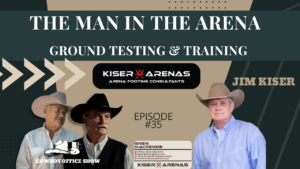
Ep 38: AWWA & The Ranch Challenge
Episode 38
The AWWA and The Ranch Challenge.
Leo Fourre, judge, BOD & professional shares the insights on The Ranch Challenge and the new development of the WWA ( Working Western Alliance).
The League of Agricultural and Equine Centers promotes and supports facility management, draws people together, and offers a network of experts that brings awareness of best practices, new developments, and looks to the horizon to prepare for the future.
Meet the Experts:
The League creates a family network feel to a competitive sector of the equine industry with the ultimate goal of unifying event venues in a way that leads to greater consistency in customer service and procedures across the nation. As the shutdowns from Covid proved, working together makes everyone better and aids the entire equine community by sharing knowledge rather than hoarding it. Their annual symposium will be hosted February 6-10, 2023 in Ocala, FL.
Challenges facing the industry (and how to meet them):
Groundbreaking News:
“The footing you can’t see is what gives the horse its confidence.” Bob Kiser
Education:
Certified Managers of Equine Centers (CMEC) supports education in three core areas:
Attaining a CMEC certification requires an average of 4 years to complete the 45 credit hours required. After acquiring the credits, a written essay on an assigned topic is presented to the education committee followed by an interview before graduating. Recertification is required every 3 years. There are currently 28 people certified.
Biosecurity (a.k.a. Why Jody stopped carrying his own sprayer and disinfectant to shows)
Why all horse owners, trainers, and exhibitors should be on the EDCC email list:
Website: CowboyOffice.com
Facebook: @cowboyofficeshow
Instagram: @cowboyofficeshow
LinkedIn: cowboy-office>
TikTok:@cowboyofficeshow
Email: Exec@CowboyOffice.com
The League of Agricultural & Equine Centers: http://www.laec.info/
Annual Symposium & Footing Academies: https://laec.info/Symposium
Equine Disease Communication Center: https://www.equinediseasecc.org/
Production and marketing by ConsultMent.Agency

Episode 38
The AWWA and The Ranch Challenge.
Leo Fourre, judge, BOD & professional shares the insights on The Ranch Challenge and the new development of the WWA ( Working Western Alliance).

Episode 37
The NRHA has 40 rule proposals on the table for 2026. We review and discuss each rule and explore the effects for the sport and association.

Episode 36 The Arabian Working Western Alliance. AWWA.
The newest challenge to the working western horse in a competitive arena. Amateurs are the highlight as well as the skills of a western horse put together in a challenging format that is more than Ranch Riding.

Episode 35 Jim Kiser from Kiser Arenas.
The Man in the Arena. He is riding forward as he shares how to measure, test and manage our performance ground to keep horses sound, performing higher and producing our events better. Join us for a great discussion.

2024 Open Reining Champion. Kaci O”Rourke and The Fireman make history as the 1st woman to win this prestigious event.
We review the event and provide data and analytics for the officiating performance relative to the professional talent displayed.

Episode 34 has an epic discussion around the common issues and scenarios in the industry. Race horses or high performance horses, change the names, venues and towns as the story may be very similar. From medications performance enhancing drugs, government regulations and the bond between horse and human along with what competition will do to human behavior. Join us for a great conversation.
Reining Licensed officials stats and measurable data:
Copyright 2022 -2025• 4D Productions LLC • Privacy | Terms | Accessibility | Sitemap • Made with by ConsultMent